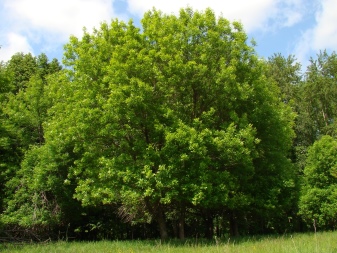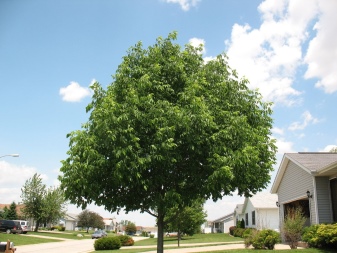Description of Pennsylvanian ash and its cultivation

Pennsylvanian ash or fluffy is a unique tree native to North America, spread in all climatic zones of the Northern Hemisphere. In Europe and Russia, it has been cultivated and used for more than two centuries due to its many advantages. In the article we will consider its characteristics, features of cultivation, scope of application.


Description
This is a very picturesque, powerful tree up to 20 m high, with a spreading (10-12 meters wide) goblet-shaped crown. A pleasant light transparent partial shade always reigns under it (it is not for nothing that the tree calls it clear). The leaves, irregular in shape, transmit light well - they are small, feathery, consist of 5-7 separate lanceolate leaves with serrate-toothed edges and small villi on the lower part. They are distinguished by a rich shade: juicy green in summer, bright yellow in autumn.
Young shoots are yellowish-green or brown-brown, their main feature is reddish tomentose pubescence. Therefore, Pennsylvanian ash is also called fluffy. But the flowers are not very decorative and are inconspicuous greenish panicles. Blossom before leaves appear, in April-May. The same tree contains both male (pistillate) and female (staminate) flowers.
Fruits - flat green lion nuts, ripen by early to mid-August. They can hang on a tree all winter.


Fluffy ash has become widespread in culture due to its many advantages:
- frost and wind resistance, feels good in all climatic zones of the Northern Hemisphere;
- less demanding on soil fertility than its closest relative - ordinary ash;
- moisture-loving, tolerates short-term flooding well, but at the same time can tolerate short-term drought;
- decorative, looks good in landscape compositions;
- strong roots hold the soil well, so the tree can be used to create soil protection belts;
- gas resistant, feels good in an urban environment;
- unpretentious and easy to grow;
- possesses valuable wood.


It successfully renews itself with seeds and shoots, grows rapidly, successfully adapts, and becomes a part of both man-made landscapes and wild phytocenoses.
Therefore, it spread not only on its native continent, but also on the other side of the ocean - in the Far East, in Japan, Europe, throughout Russia.
In the wild, it settles in humid places, near water, in clearings, in mixed forests. Sometimes forms ash forests (there are usually several types of ash in them). Under good conditions, it lives for more than 150-300 years. The first years it grows very quickly - 50 cm in height per year. Begins to bloom and bear fruit from 15-20 years.


Popular varieties
Pennsylvania ash comes in 2 forms:
- ordinary;
- variegated (aucubolist, aucubofolia).
The aukubolistic form is distinguished by a more decorative color of the leaves. They are light green with golden and creamy spots and stripes that make them variegated, similar in color to Japanese aucuba (hence the name). Usually larger and longer than the Pennsylvanian Ash, and less fluffy. Due to its spectacular foliage coloration, the tree is popular in landscape design. It tolerates pruning more easily than an ordinary form (not only sanitary, but also molding pruning is allowed). There are no other significant differences from the usual form.


Planting and grooming tips
Propagated by seeds or seedlings. For decorative purposes, it is recommended to use seedlings. Growing Pennsylvania Ash is easy, although there are some considerations to consider. They relate to the choice of the landing site:
- prefers a sunny place;
- prefers organic-rich, acid-neutral soils with sufficient calcium;
- does not tolerate soil salinization;
- goes well with almost any deciduous species, but very badly - with conifers (up to mutual "poisoning").


In colder climates, planting is best done in the fall. It is carried out as follows:
- before planting, the root system must be thoroughly saturated with moisture;
- it is recommended to fill the drainage at the bottom of the pit - sand or crushed stone with a layer of about 15 cm;
- a mixture of turf, sand and humus is poured into the planting pit in a ratio of 1: 1: 2;
- the seedling should not be buried unnecessarily; it is advisable to place the root collar just above the ground level;
- after planting and the first 3-5 days, it is imperative to water the plant.


Caring for a tree in the early years includes the following procedures:
- regular loosening (to a depth of 7-20 cm);
- removal of large weeds;
- peat mulching;
- watering - not required at normal times, but in case of drought, the tree is watered at the rate of 10-15 liters of water for each square meter of crown size;
- sanitary pruning - the usual form of fluffy ash is painful, so the procedure is carried out only if necessary and in a small amount;
- top dressing - nitrogen-containing fertilizers are applied in early and late spring, in the fall they are fed with nitroammophos;
- for the winter, it is better to wrap it with a covering material.


Diseases and pests
Not very often, but it happens that the ash is affected by pests:
- ash wood - damages leaves;
- ash bark beetle - damages bark, branches;
- Ash seed weevil - damages seeds.



Of the mushrooms, ash most often suffers from:
- gray-yellow tinder fungus - causes red-brown heart rot;
- fungus Neetva gebigena - causes wood cancer.
These diseases can cause serious damage to the tree, up to its complete death (necrosis of the trunk and branches). The fight is as follows:
- sanitary felling;
- spraying with insecticides and fungicides - “Kinmiks”, “Decis” are applied against the ash shpanka; from the ash beetle, a double treatment with “Karbofos” is used;
- early collection of seeds before seed eater larvae emerge;
- in case of cancer, the excision of the affected areas is carried out, followed by treatment with an antiseptic and putty with garden varnish.


Where is it used?
Pennsylvania Ash is used in landscaping and beautification.
- Downy ash is prized by landscape designers for its decorative properties. Openwork branches and a powerful crown look great at any time of the year. Even peculiar fruits - lionfish are an ornament. Ash can be planted near an artificial stream or pond, it looks great in single plantings, compositions with other trees and shrubs. For example, a popular solution is a Mediterranean-style composition with Pennsylvania ash as the background. It is perfect for setting up a recreation area - the play of light in the leaves and the cool, transparent partial shade instill peace. It is not for nothing that in ancient times many peoples considered ash a mystical tree of life and believed that it was able to restore exhausted forces.
- It is very widely used in urban landscaping. Here, its gas resistance, the ability to exist in the polluted air of a metropolis, is valuable. In addition to aesthetic and recreational, it also helps to solve environmental problems, making the environment healthy. Its leaves are able to bind harmful substances (1 kg of leaves per season is able to bind 10-12 g of sulfur dioxide), emit essential oils, saturate the air with oxygen.
- Due to the peculiarities of the root system, it is able to hold the soil well.Therefore, it is very often used for protective plantings: it is planted in clearings, in field protection belts, on landslide-prone banks and ravine slopes that are destroyed as a result of washing out and erosion.
- Ash forests (emerged independently or purposefully planted) have a beneficial effect on the environment - they protect river banks, soil, and in some places they have a spawning protection function.


The main commercial use of Pennsylvanian ash is due to the high value of its wood, which equates to ebony and mahogany.
Wood has unique characteristics:
- it is one of the most durable types of ash, in terms of strength it surpasses oak or beech (Brinell hardness is 4, 1 - this is 6-8% higher than that of oak, density - 742 kg / m3 with a moisture content of 12%);
- at the same time, the breed is very elastic and resistant to prolonged deformation (11.4 GPa, surpasses oak and many other species);
- has increased impact resistance;
- the texture of the wood is very beautiful, dense, with straight regular grains, very similar to oak, but with less pronounced rays;
- with the correct drying technology, it acquires high resistance to mold damage;
- has a beautiful light color - from creamy white to beige, light brown.
Due to its hardness and structural features, ash is difficult to process, it is difficult to cut and processed with abrasive tools (it is 1.55 times harder to cut than oak, and 1.75 times than pine). But the result is worth the effort - furniture and products from Pennsylvania ash wood look aristocratic and presentable, while very elegant due to the light color.


In addition to furniture, ash is used to make expensive high-quality parquet, veneer for plywood, and staircase elements. Also, this shock-resistant type of wood is ideal for the manufacture of sports equipment (oars, bows, rackets), for the handles of various household tools. Other parts of the tree find their use as well.
- Specially prepared fruits (nuts) taste like pickled walnuts and are used as a spicy condiment. They are oily, contain about 30% vegetable fat (ash is a relative of olives) and many useful substances.
- Bark, buds, flowers, leaves are used in folk and official medicine.
- Dyes (brown, blue, black) and tannins are obtained from the bark and leaves.

































































The comment was sent successfully.